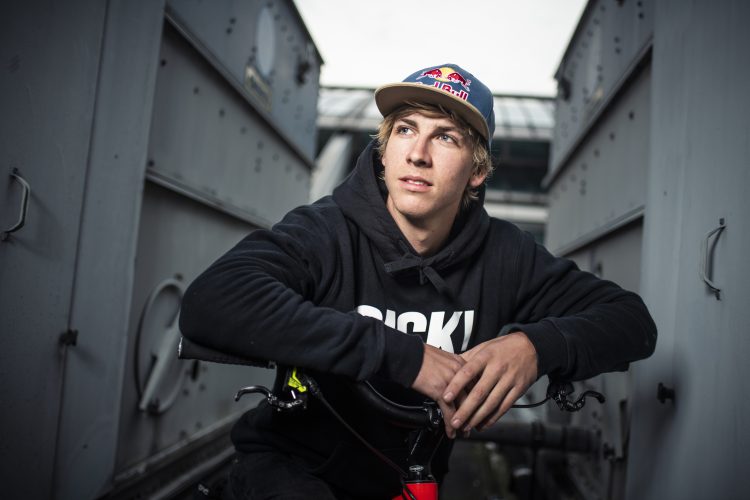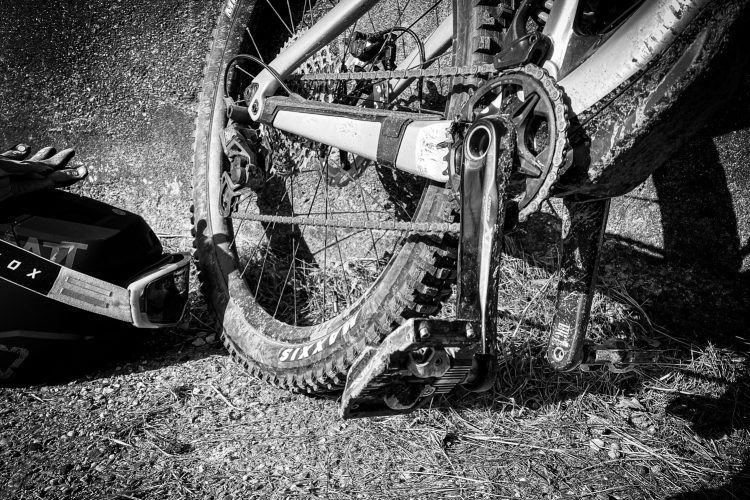Recently, I had the pleasure of meeting up in Fruita with the amazing Mtbikerchick and Delphinide for a great weekend of camaraderie and sweet singletrack. After hitting the trails, we gathered the spouses and chitlins to share mountain biking stories over local Colorado beer and pizza. Many of my stories were comprised from my husband and I’s first trip west of the Mississippi River. Our destination? A little town that every legitimate mountain biker (i.e. those not sporting Walmart bikes and toe cages) seemed to be talking about: Moab.
After training for months at San Felasco State Park in Florida, we hit the road for a vacation. Note: San Felasco is more of a cross country beginner to intermediate trail system, though they have since upgraded a fair number of trails. We were poor college students then, so the trip was on a very tight budget and wedged between the summer and fall semester. We spent most of our loose change buying new full suspension bikes, that we were certain instantly made us legitimate, hardcore mountain bikers. Looking back, there were many things we should have known, or at the least realized, prior to venturing west in August.

#1: The desert is hot.
And August is unbelievably hot in the desert! I had never felt the sensation of the moisture evaporating from my eyeballs prior to arriving in Moab. While Florida is miserable during the summer, the brunt of the heat is from 11am to 2pm, after which you get a little bit of relief. That is not the case in the desert: it just keeps getting worse throughout the day until the sun sets. We had naïvely planned on riding two trails a day, one in the morning, and one in the afternoon to work off lunch. That quickly went out the window the first day after we scraped ourselves off of Slickrock, out of water, dehydrated, and sunburnt. All this before McDonald’s even stopped serving breakfast.
Tip: If you want to prepare for the desert heat in the summer, set your oven to 450, open the door, and hold your face in front of it.

#2: Hydrate
The amount of water you will need is unfathomable. If you’re in the desert in the summer, especially at elevation, a 100oz pack may only last you a couple of hours if you’re lucky. On our trip to Moab, my husband and I each had an 80oz hydration pack and two large water bottles. By mile 5 on Slickrock, I had to begin rationing my water. We both ran out of water with over a mile to go to the trailhead (though at the time we didn’t know if we had a mile or 10 miles to go). You’re not likely to come across any standing water or streams either if you run out. And if you do find water, you will likely wish you had chosen to eat a dozen tacos or one of those new breakfast waffle tacos from Taco Bell than sip stagnant water.
Tip: Though water is hard to come by in the desert, I try to always carry a water purification pen or system when trying out new trails. Also, if you do find yourself dehydrated when you return to the trailhead, don’t chug a 60oz bottle of sports drink. Trust me when I say that your body will likely reject it…

#3: The West is rough.
In the east, every campsite has running water. The facilities consist of toilets that flush, as well as showers. Sometimes there’s even hot water for the showers (who pays for hotels with that kind of luxury?!). You can forget all that when you cross the mighty Mississippi. The facilities will consist of a fancy port-o-potty. That it’s. The summer heat makes these “facilities” ripe for the picking, too. Service at local establishments is inversely proportional to your stench zone. The larger your stench zone, the less service you receive.
Tip: Make sure to bring wet wipes and hand sanitizer if you decide to rough it. Those fancy camp shower bags are handy as well.

#4: The terrain is unforgiving.
It’s typical in the east to have branches and other overgrowth encroaching into the trail. You typically don’t think twice about it (unless it resembles poison ivy or oak). Branches will bend and give if you hit them. The biggest concern is the rubber band effect you get from branches if you’re following someone too closely. The first time I attempted to ride through a branch overhanging the trail, I was practically clothes-lined.
And then there’s the cliffs, large boulders, cacti, and large predatory animals that could make an afternoon snack out of you out West. The desert is a rough place with just about everything out to get you.
Tip: After I tangled with my first prickly pear patch, I now ride with a pair of tweezers in my pack. I don’t know anyone else that does, to be honest. But I promise you, if you do end up tangled in cacti, those tweezers will become your savior.
#5: Altitude
Almost every place out west is at a relatively high altitude. During our stay in Moab, we decided to splurge and get a shuttle ride to do the Porcupine Rim trail. As we were sitting in the van on our way up, we realized everyone one else was decked out in winter biking gear. Having experienced the oven-like effect in town, we were a bit confused as to their choice of clothing. Sure, we figured it would be colder at the top of the mountain. But if it was 115 in town, how cold could it be an hour up the mountain? Turns out, just above freezing. Needless to say, our spandex and thin summer jerseys (typical roadie attire, mind you) made us look hardcore. And stupid. In Florida, the highest point in the state is if you stand on the roof of your car. I quickly found out that there’s much less oxygen when you’re more than a mile high in elevation.
Tip: Your body will need more water at higher elevation as well.

These are just a few of the lessons I learned (the hard way) while traveling and living in the west. Though the desert was daunting for me at first, I highly recommend a destination trip to one of the many acclaimed trails out west. It’s not as green or as humid, but the beauty never ceases amaze me!
Your turn: Do you have any hard lessons you learned while biking in the desert? Do you prefer the green canopy of the east coast or the cactus-lined rocky trails of the desert?




















16 Comments
May 14, 2014
Also, go for one of the campsites in town in Moab. They have showers and hot tubs. It's TOTALLY worth it.
Also tubeless tires FTW ...
All that aside, I love the West and will never willingly move back East.
May 14, 2014
Showers AND hot tubs?!?! Epic fail on our part...
May 16, 2014
May 17, 2014
May 14, 2014
Always wear sunscreen, even if it is cloudy when you start, because things change fast in the desert. A small first aid kit is usually a good idea too on any desert ride--because you are absolutely right---the rocks are so much less forgiving than East Coast loamy singletrack.
There is no good way to really prep for the change in altitude except keep your fitness up before you go...especially longer rides on your road or mtn bike. However, as you suggested, staying hydrated during the entire duration of your vacation in the desert helps, and avoid drinking a lot of alcohol, sports drinks, or anything with a high solute or sugar content. They will suck you dry. Skratch labs probably has the best osmolarity for any performance drink...if you simply must have some. I've never tried Nuun tabs, but I have friends that swear by them, but I've used Sports Legs and they work well if you are just drinking water---and you don't have to dirty your hydration pack.
Camping is awesome in the desert, especially Moab, but don't forget about the Lazy Lizard---which is cheap and includes showers and an experience :)
To piggy back on maddslackers comment--make sure you have adequate Stans in your tubeless tires, and/or carry a small refresher bottle if you are doing longer rides like the Whole Enchilada or Mag 7. Goatheads suck...and they are everywhere on some trails.
May 16, 2014
So jealous about the Lazy Lizard. Really wish I would have known about that when we went there the first time almost 8 years ago... I made a rule after that trip that all campsites must have running water and showers. Only possible in the east though. Back to roughing now that we live in the west!
May 14, 2014
May 14, 2014
Also, when we're camping out west we always take a sunshower with us. Fill it up in the morning and leave it in a nice sunny spot. It'll be piping hot by the time you get back. Even if you just have to hang it over the side of the car, you can at least rinse off the dust. Often though we can find a tree to hang it from.
The tweezers are a great idea! I'm totally putting a pair in my pack this evening. Great article!
May 14, 2014
May 14, 2014
May 15, 2014
One question, when you talk of biking Porcupine Rim... did you shuttle all the way up to Geyser Pass and ride the Whole Enchilada? Otherwise Porcupine Rim isn't _that_ much higher than Slickrock Trail.
... and you didn't mention how much nicer the campgrounds are now than they were in the 90s... still very primitive... but compared to now, it's darn near Motel 6 ;)
Oh... about the book... it's being updated for the tons of new mountain bike-specific trails... look for it this fall!
PS... my book used to be called simply, Mountain Biking Moab... but the publisher bought out another publisher with a similar title... so mine became, "Mountain Biking Moab: Pocket Guide" ... and now you know more than you ever wished to about guide book politics.
May 16, 2014
We were dropped off at Hazard County. I don't remember how far that is from the top, but I think it's pretty darn close. I guess "porcupine rim" isn't very accurate.
I will keep an eye out for your book!
May 16, 2014
Your piece brought back great memories... my first ride on my first summer trip there was Hurrah Pass... in July... at around noon... I felt my feet burning through my shoes... I was so hot that I though my head would explode... I found a tiny slab of shade by a rock.. dumped some water on my head.. I probably came close to dying... but I sure learned a lesson...
Thanks for sharing your experiences!
May 16, 2014
Mar 16, 2015
The desert soil (exclusive of any slickrock), such as it is, easily turns to sand under the wheels of ATVs. Much of the time as I labored through these sand pits I pined for my SORBA-maintained trails back in Georgia.
May 15, 2014